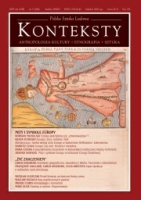Antropologia jako maska, kostium, metafora. Przypadek Michela Leirisa i Rogera Caillois; Między subwersją aestetyką – surrealizm ifotografia
Anthropology as a Mask, a Costume, a Metaphor: the Case of Michel Leiris and Roger Caillois; Between Subversion and Aesthetics – Surrealism and Photog
Author(s): Tomasz Szerszeń, Karolina LewandowskaSubject(s): Anthropology
Published by: Instytut Sztuki Polskiej Akademii Nauk
Keywords: anthropology; Michel Leiris; Roger Caillois
Summary/Abstract: Michel Leiris and Roger Caillois are the authors of two rather strange autobiographical works: L’Âge d’Homme, and a self-analytical essay La Nécessité d’esprit, not published during the author’s lifetime. Leiris began writing L’Âge d’Homme before he was thirty years old, and Caillois completed La Nécessité d’esprit – his first book – when he was less than twenty years of age. In other words, we are dealing with two works that treat the problem of the autobiography in a truly surrealistic manner: they are the stories of a life that has not been lived but has barely began. L’Âge d’Homme and La Nécessité d’esprit also relate, in a less unobvious way, to a different theme: the attitude of the authors to 'scientificality'. After all, Leiris and Caillois were men of science (an ethnographer and a sociologist). Reading their learned analyses, one could have the impression that anthropology is a metaphor, a mask or a theatrical costume. In the case of Leiris, the onset of interest in ethnography coincided with the inauguration of work on L’Âge d’Homme. This was also the moment when the author became involved in editing the avant-garde periodical „Documents”, in which anthropology and ethnography were for the first time applied as a sui generis quasi-science, a scientific discourse transferred, laid open, at times mocked and simultaneously proposed misleadingly as a scientific debate. It was precisely for the needs of „Documents” that Leiris assumed the role of an ethnographer, and adapted himself – in the manner of one of the insects described by Caillois – to 'writing science'. For Caillois too science – sociology, anthropology – is a mask concealing the temptation to write an autobiography, a metaphor of one’s existential situation. Here, the key figure is that of the praying mantis, a combination of sexuality and autobiographical qualities. Similarly to Judith, the praying mantis is connected with an autobiographical project of describing emptiness, a life not lived, whose place has been taken by science. The texts by Leiris and Callous render us helpless. We are not certain whether that which has been presented as a scientific discourse is actually one. Or is it a metaphor, a mask, a game played by textual mirrors, in whose course the authors themselves have provided the best possible keys to an interpretation of their texts that, in turn, function as perverse auto-commentaries. This is a science that, in the fashion of the headless Acčphale, is always missing something, in which something is not in its proper place, but is shifted and multiplied. This is a science that resembles a cruel praying mantis, and has been created to make the naive researcher feel at loss. Karolina Lewandowska Between Subversion and Aesthetics – Surrealism and Photography The functions fulfilled by Surrealistic photographs published in periodicals remain suspended between two extremities, orders and different practices, between subversion and aesthetics. The first
Journal: Konteksty
- Issue Year: 2009
- Issue No: 03
- Page Range: 170-175
- Page Count: 6
- Language: Polish
- Content File-PDF

